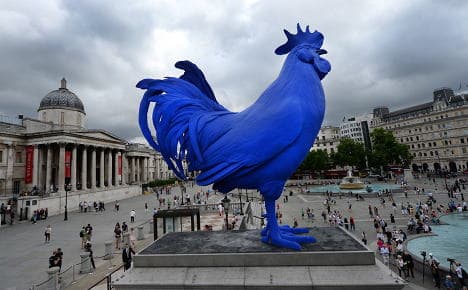Huge German cockerel lands in London

A German artist has ruffled feathers after installing a huge blue cockerel in London's Trafalgar Square on Thursday. She did not realise she was putting a symbol of France in a site marking victory over Napoleon.
Standing 4.7 metres tall and coloured a vivid ultramarine, the fibreglass rooster was sculpted by German artist Katharina Fritsch and will watch over the famous square for 18 months.
Fritsch, 57, has said she did not know the cockerel was an unofficial French symbol, and that she intended it to represent strength and regeneration. "But it's a nice humorous side-effect to have something French in a place that celebrates victory over Napoleon," she told the Guardian newspaper, adding: "He has come back as a cockerel!"
Titled Hahn/Cock, it was officially unveiled by London's Mayor Boris Johnson – who said he would try to refrain from making any rude "double entendres" about the erection of a giant cockerel at the London landmark.
"I just had an emergency briefing from the brilliant artist, Katharina," he joked.
"She said it was all to do with a woman's rendition of a man... or something like that. I think it's one of those occasions where politicians have to resist any kind of artistic interpretation."
It is the latest artwork to stand on the tourist hotspot's "Fourth Plinth".
Trafalgar Square is named after the victory of the British Royal Navy over the French and Spanish fleets at the Battle of Trafalgar in 1805, a key conflict in the Napoleonic Wars.
The cockerel will be sited on the other side of the square from Nelson's Column, a monument commemorating the English naval hero Admiral Horatio Nelson, who was killed during the battle.
A group of conservationists had tried to get the bird banned from the square, saying it was "totally inappropriate, however fanciful and dramatic it might appear to be".
There are four large stone plinths at each corner of Trafalgar Square, three of which bear statues. The fourth was supposed to hold a statue of a horse commissioned in 1841, but due to insufficient funds it was never completed.
Since 1998 the fourth plinth has been used to showcase temporary pieces of art, and has so far hosted works including a giant ship in a bottle and a huge nude statue of the English artist Alison Lapper, who was born without arms, during her pregnancy.
AFP/jcw
Comments
See Also
Standing 4.7 metres tall and coloured a vivid ultramarine, the fibreglass rooster was sculpted by German artist Katharina Fritsch and will watch over the famous square for 18 months.
Fritsch, 57, has said she did not know the cockerel was an unofficial French symbol, and that she intended it to represent strength and regeneration. "But it's a nice humorous side-effect to have something French in a place that celebrates victory over Napoleon," she told the Guardian newspaper, adding: "He has come back as a cockerel!"
Titled Hahn/Cock, it was officially unveiled by London's Mayor Boris Johnson – who said he would try to refrain from making any rude "double entendres" about the erection of a giant cockerel at the London landmark.
"I just had an emergency briefing from the brilliant artist, Katharina," he joked.
"She said it was all to do with a woman's rendition of a man... or something like that. I think it's one of those occasions where politicians have to resist any kind of artistic interpretation."
It is the latest artwork to stand on the tourist hotspot's "Fourth Plinth".
Trafalgar Square is named after the victory of the British Royal Navy over the French and Spanish fleets at the Battle of Trafalgar in 1805, a key conflict in the Napoleonic Wars.
The cockerel will be sited on the other side of the square from Nelson's Column, a monument commemorating the English naval hero Admiral Horatio Nelson, who was killed during the battle.
A group of conservationists had tried to get the bird banned from the square, saying it was "totally inappropriate, however fanciful and dramatic it might appear to be".
There are four large stone plinths at each corner of Trafalgar Square, three of which bear statues. The fourth was supposed to hold a statue of a horse commissioned in 1841, but due to insufficient funds it was never completed.
Since 1998 the fourth plinth has been used to showcase temporary pieces of art, and has so far hosted works including a giant ship in a bottle and a huge nude statue of the English artist Alison Lapper, who was born without arms, during her pregnancy.
AFP/jcw
Join the conversation in our comments section below. Share your own views and experience and if you have a question or suggestion for our journalists then email us at [email protected].
Please keep comments civil, constructive and on topic – and make sure to read our terms of use before getting involved.
Please log in here to leave a comment.